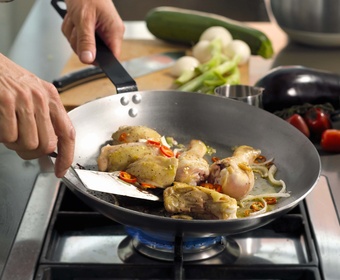About frying pans
A professional kitchen puts huge demands on a frying pan. In this environment, cast iron, stainless steel or carbon steel are the only feasible options.
It has to withstand high temperatures.
– Chef and food designer Micke Göransson’s first demand on a frying pan
Iron or steel?
Non-stick coatings like Teflon cannot withstand high temperatures. Pros will recommend frying pans mad from cast iron (skillet), stainless steel or carbon steel. The rest is a matter of personal preferences.
In symbiosis with your pan
Another reason to buy a long-lasting pan is the fun and satisfaction of having plenty of time to get acquainted with your tools. A pan made from nothing but steel or iron will live in symbiosis with you and your stove for many, many years.
Frying basics
- Let the pan heat up before starting. Don’t be afraid of high temperatures.
- Also, let the frying fat heat up before starting.
- For the desired result, always dry food before it goes in the pan.
- Don’t try frying too much at a time. This will cool down the pan rather than heat up the food.
- Patience. Give the food a little time to sear on the surface and to come unstuck.
- Invest in a proper steel spatula and kitchen tweezers.
Always greased
The key to a working, seasoned pan made from carbon steel or cast iron is a layer of fat. The frying surface must never dry out or oxidize.
Better with time
The non-stick qualities of carbon steel pans and cast iron pans improve over time. The seasoned surface will darken in patches and eventually turn almost evenly black. Very stylish, if you ask us.
Pancakes are great
Some chefs claim that nothing seasons a new pan like frying pancakes. Give it a try – and find your own tricks and truths.
No detergents
Washing-up liquid will ruin the pan’s natural non-stick coating. Wash with hot water only (“deglaze”), and season with fat again…
How to re-season a pan:
Sooner or later the pan’s protective layer will thicken and lose its non-stick properties. How to season it again:
- Cover the bottom with about 5 mm of coarse salt.
- Bring the pan to high heat for about 2 minutes. Shake now and then.
- The salt will absorb burnt food and fat. Throw away the salt and let the pan cool before seasoning it again:
- Cover the bottom with a heat-resistant oil and apply moderate heat for about 30 minutes.
- Pour away the oil and dry with paper. Like new again!
The Maillard effect
Frying creates new aromas and flavors on the surface of the food. This is because proteins and carbohydrates react forming tasty molecules in hundreds of combinations. This is known as the Maillard effect.
Above 100°C
The Maillard effect only takes place if the food is dry on the surface, so the temperature must be above boiling, ideally 140 to 165°C.
Suitable weight
Weight is a good thing in a frying pan. The mass of the pan is crucial for maintaining a high temperature when the chef is adding food.
Better too big
You want a high and steady temperature when frying. A pan that is too large is better than a pan that is too small.
Avoid acidity
Natural acids in, for example, vinegar, lemons and tomatoes, can dissolve the natural coating in cast iron skillets and carbon steel pans.
Caring for steel and iron pans:
- Wash new pans with hot water and detergent to get rid of dirt and/or any protective layers. Dry carefully.
- Cover the bottom with a heat-resistant oil and place pan on moderate heat for at least 10 minutes.
- Remove oil and dry pan with paper. It is now seasoned and ready to use!
- Wash with hot water only. Dry carefully and season with a thin layer of fat. For full effect, heat the pan when doing this.
- If forced to use detergent, you must re-season the pan afterwards.



